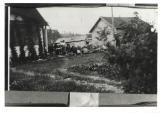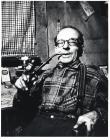1
Charlie Paquette had a few packhorses and hired out as a packer in summer and he trapped in winter, his home cabin being on the south side of the river. Being in the packing business, every piece of rope was precious to him, so he made a practice of picking up every piece he found lying around. One day he picked up a piece and he also took the horse that was attached to the rope!3
This was in 1915 and his was the first court trial held in Hudson's Hope. It was held outdoors in front of the telegraph office, so as to accommodate all the amused and interested settlers. When Charlie was asked if he had anything to say, he replied, "How could I help it if there was a horse on the other end of the rope?". He was fined $25.00 and costs - a sum his trapper friends quickly raised and paid.5
Harry Garbitt, met a couple of men in Edmonton who were taking horses north and Harry hired on at 50 cents a day. It seems that they "borrowed" horses along the way and had many more head when they reached the Peace River than when they started out. They sold most of the horses and, as the trail grew hot, hastened farther and ever farther north to avoid the Mounties.7
Reginald Withers Shaw, more commonly known as "Deadly" was not so much of a criminal as his name implied. One of his favorite words was 'deadly' instead of awful, worse, terrible, etc., eventually he became "Deadly". Somehow, after a few years, the name was again changed to Dudley. Many people in Hudson's Hope called him "Uncle Dudley".9
Near the end of 1918, the mailcarrier arrived from Finlay Forks with the news that he had found a member of the community shot to death in his cabin up the river.The dead mans partner was never found, so the investigators assumed he was the guilty party and that he had perished in the woods trying to escape.
Six year later, Bill Innes confessed to Shorty Webber that it had been he who had committed the murders! Burying the first man under the cabin floor while lying in wait for the second man to return home and then shooting him dead as well. Not long after this confession, Bill Innes took his own life.




